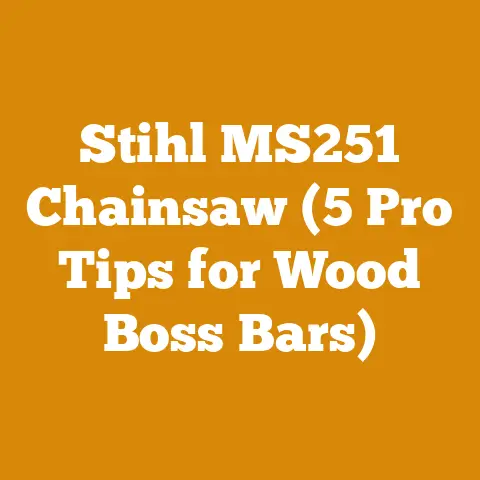Is Sweet Gum Good Firewood? (5 Expert Tips for Best Use)
Alright, let’s dive into the world of firewood, specifically focusing on that often-debated species: Sweet Gum.
Is Sweet Gum Good Firewood? (5 Expert Tips for Best Use)
As a guy who’s spent a good chunk of my life in the Appalachian foothills, wrestling with everything from seasoned oak to stubborn maple, I know a thing or two about what makes good firewood. And I also know the debates that rage around certain wood species. Sweet Gum (Liquidambar styraciflua) is one of those. It’s a common tree in the eastern United States, particularly abundant in the South, and many a homeowner has looked at a fallen Sweet Gum and wondered: “Can I burn this?”
The short answer is yes, you can burn Sweet Gum. But the long answer, as always, is a lot more nuanced. Let’s break it down, shall we? I’ll share my experiences, along with some data and tips to help you decide if Sweet Gum is right for your wood-burning needs.
Understanding Sweet Gum: The Good, the Bad, and the…Squishy?
Sweet Gum is a hardwood, but it’s often considered a “softer” hardwood compared to oak, hickory, or even maple. This means it’s less dense, which directly impacts its burning characteristics.
- The Good: Sweet Gum splits relatively easily when green, especially compared to stringy elms or knotty oaks. It also dries faster than many denser hardwoods, which is a significant advantage if you’re in a hurry to build up your firewood reserves.
- The Bad: Its lower density translates to a lower BTU (British Thermal Unit) rating. BTU measures the amount of heat released when wood burns. Sweet Gum typically clocks in around 16 million BTU per cord, significantly lower than, say, White Oak, which boasts around 24-25 million BTU per cord. This means you’ll need more Sweet Gum to generate the same amount of heat.
- The…Squishy?: Freshly cut Sweet Gum can be incredibly sappy. That sap can be a nuisance, gumming up your chainsaw and making it sticky to handle. This sap also contributes to a slower drying time if not properly managed.
My Personal Experience: I remember one particularly wet spring when a massive Sweet Gum came down in my neighbor’s yard. He was overwhelmed, so I offered to help him clean it up in exchange for some of the wood. I thought I was getting a great deal until I started cutting it. The stuff was like a sponge! It took longer to dry than I anticipated, and I had to clean my saw more frequently than usual. However, once it was dry, it burned surprisingly well for shoulder-season fires.
5 Expert Tips for Getting the Most Out of Sweet Gum Firewood
Alright, so you’ve got some Sweet Gum, and you’re determined to burn it. Here are my top 5 tips to make the most of it:
1. Season, Season, Season (and then Season Some More)
This is the golden rule of firewood, regardless of species, but it’s especially crucial for Sweet Gum. The higher moisture content in fresh Sweet Gum not only reduces its heat output but also increases creosote buildup in your chimney. Creosote is a flammable byproduct of incomplete combustion, and it’s a major fire hazard.
Best Practices for Seasoning:
- Split it early: Splitting the wood exposes more surface area, accelerating the drying process. I aim to split Sweet Gum within a week or two of felling the tree.
- Stack it properly: Stack your firewood off the ground on pallets or rails to allow for air circulation. A single row stack is better than a massive pile, as it allows air to circulate more freely. Leave space between rows as well.
- Location, location, location: Stack your wood in a sunny, breezy location. Sunlight helps evaporate moisture, and wind carries it away.
- How long to season?: Aim for at least 6-12 months of seasoning. Ideally, you want the moisture content to be below 20%. You can use a moisture meter to check this. These are inexpensive and readily available at most hardware stores.
- The “Clink” Test: This is an old-school method, but it works. Bang two pieces of seasoned wood together. If they make a hollow “clink” sound, they’re likely dry enough to burn. If they sound dull and thud-like, they still need more time.
Data Point: A study by the US Forest Service found that properly seasoned firewood (regardless of species) burns up to 50% more efficiently than green wood.
2. Mix and Match: The Buddy System for Firewood
Sweet Gum isn’t the best choice for primary heating in the dead of winter. Its lower BTU rating means you’ll be constantly feeding the fire. However, it’s an excellent option for shoulder-season fires (spring and fall) or for mixing with denser hardwoods.
The Mixing Strategy:
- The Base Layer: Start your fire with a layer of denser hardwoods like oak, hickory, or ash. These will provide a long-lasting, hot base.
- The Kindling and Sweet Gum: Use Sweet Gum as kindling and for maintaining the fire once it’s established. It lights easily and burns relatively quickly, providing a good flame.
- The “Top-Off”: As the Sweet Gum burns down, add more of your denser hardwoods to keep the heat consistent.
Why this works: The denser hardwoods provide sustained heat, while the Sweet Gum provides quick flames and helps to ignite the larger pieces. It’s a synergistic approach to firewood burning.
My Experience: I often mix Sweet Gum with oak and maple. I use the oak for overnight burns and the Sweet Gum for quick evening fires when I don’t want to stoke the fire all night. It’s a great way to use the Sweet Gum without feeling like I’m constantly feeding the beast.
3. Mind Your Chimney: Creosote Control is Key
As I mentioned earlier, Sweet Gum tends to produce more creosote than denser hardwoods, especially if it’s not properly seasoned. Creosote buildup is a serious fire hazard and can also damage your chimney.
Creosote Control Strategies:
- Burn hot fires: A hot fire promotes more complete combustion, reducing creosote formation. Don’t let your fire smolder for extended periods.
- Proper air supply: Ensure your stove or fireplace has adequate air supply. Restricted airflow leads to incomplete combustion and increased creosote.
- Regular chimney inspections: Have your chimney inspected and cleaned by a professional at least once a year, or more frequently if you burn a lot of wood.
- Creosote sweeping logs: These logs contain chemicals that help to break down creosote buildup. They’re a good supplement to professional chimney cleaning, but not a replacement.
Data Point: The National Fire Protection Association (NFPA) estimates that creosote buildup is a contributing factor in over 25,000 residential fires each year in the United States.
4. Its sappy nature can quickly dull your chainsaw chain, and its sometimes stringy grain can make splitting difficult.
Chainsaw Considerations:
- Sharp chain is essential: Keep your chainsaw chain sharp. A dull chain will bog down in the sap and make cutting more difficult and dangerous. I sharpen my chain more frequently when cutting Sweet Gum than when cutting oak.
- Chain oil: Use a high-quality chain oil to lubricate the chain and prevent it from overheating. Consider using a bar and chain oil specifically designed for softwoods, as these often contain additives that help to prevent sap buildup.
- Cleaning: Clean your chainsaw regularly, especially the bar and chain, to remove sap and debris. I use a solvent specifically designed for cleaning chainsaws.
- Consider an electric chainsaw: For smaller Sweet Gum trees, an electric chainsaw can be a good option. They’re quieter, lighter, and require less maintenance than gas-powered saws.
Splitting Strategies:
- Split it green: Sweet Gum is much easier to split when it’s green. As it dries, the fibers become tougher and more difficult to separate.
- Use a splitting maul or axe: A splitting maul is a heavy, wedge-shaped tool designed for splitting wood. An axe can also be used, but it’s less effective for larger rounds.
- Hydraulic log splitter: If you’re processing a large volume of Sweet Gum, a hydraulic log splitter can save you a lot of time and effort.
- Wedges: For particularly stubborn rounds, use wedges to help split the wood. Drive the wedges into cracks or along the grain using a sledgehammer.
- The “Noodle” Cut: If you encounter a particularly knotty or stringy piece, try making a series of parallel cuts (noodles) with your chainsaw across the face of the round. This weakens the fibers and makes it easier to split.
My Tool Preference: I prefer using a hydraulic log splitter for Sweet Gum, especially for larger rounds. It’s much faster and easier than splitting by hand, and it reduces the risk of injury.
5. Don’t Discard the Bark: Kindling Gold
Sweet Gum bark is surprisingly flammable, making it excellent kindling. It’s thin, dry, and catches fire easily.
How to Use Sweet Gum Bark:
- Collect it: As you’re processing the wood, collect the bark and store it in a dry place.
- Break it up: Break the bark into small pieces.
- Use it as kindling: Use the bark to start your fires. It works particularly well with small twigs and branches.
Why it works: The thin, dry nature of the bark allows it to ignite quickly and easily, providing a good base for building a fire. It’s a great way to make use of every part of the tree.
A Cautionary Tale: Be mindful of insects when collecting bark. Some insects, like termites and carpenter ants, can infest bark. Store the bark in a sealed container to prevent them from spreading.
Sweet Gum vs. The Competition: A BTU Breakdown
To put Sweet Gum’s BTU rating into perspective, let’s compare it to some other common firewood species:
| Wood Species | Approximate BTU per Cord |
|---|---|
| White Oak | 24-25 million |
| Red Oak | 23-24 million |
| Hickory | 25-28 million |
| Sugar Maple | 24 million |
| Ash | 20-24 million |
| Sweet Gum | 16 million |
| Yellow Poplar | 15 million |
| Eastern White Pine | 12-16 million |
As you can see, Sweet Gum falls towards the lower end of the spectrum. It’s comparable to Yellow Poplar and Eastern White Pine, which are often considered “softwoods.”
Key Takeaway: Sweet Gum is not the most efficient firewood, but it can still be a valuable resource, especially when used strategically.
The Environmental Angle: Sustainable Harvesting
When harvesting any wood for firewood, it’s important to consider the environmental impact. Sustainable harvesting practices ensure that forests remain healthy and productive for future generations.
Sustainable Harvesting Tips:
- Harvest selectively: Only harvest trees that are dead, dying, or pose a hazard. Leave healthy trees to continue growing.
- Avoid clear-cutting: Clear-cutting can damage the ecosystem and lead to soil erosion.
- Replant trees: If you’re harvesting trees on your own property, consider replanting trees to replace the ones you’ve removed.
- Obtain permits: Check with your local authorities to see if you need a permit to harvest firewood.
- Leave wildlife habitat: Avoid disturbing wildlife habitat when harvesting firewood.
The “Leave No Trace” Principle: When harvesting firewood in a natural area, follow the “Leave No Trace” principle. Pack out everything you pack in, and minimize your impact on the environment.
My Approach: I always try to harvest firewood sustainably. I focus on dead or dying trees and avoid disturbing wildlife habitat. I also replant trees to help maintain the health of the forest.
The Cost-Effectiveness Equation: Is Sweet Gum Worth It?
The cost-effectiveness of using Sweet Gum as firewood depends on several factors, including:
- Availability: If Sweet Gum is readily available and free (e.g., from your own property), it can be a very cost-effective option.
- Heating needs: If you have high heating needs, Sweet Gum may not be the most cost-effective choice, as you’ll need to burn more of it to generate the same amount of heat.
- Labor: The amount of labor required to process Sweet Gum can also impact its cost-effectiveness. If you have to pay someone to cut and split the wood, it may be more cost-effective to purchase denser hardwoods.
- Equipment: If you already own the necessary equipment (chainsaw, log splitter, etc.), Sweet Gum can be a more cost-effective option.
A Simple Calculation: Let’s say you can get a cord of Sweet Gum for free, but a cord of oak costs $200. If you need twice as much Sweet Gum to generate the same amount of heat as oak, then the Sweet Gum is effectively costing you $400 in terms of labor and handling.
The Bottom Line: Evaluate the cost-effectiveness of Sweet Gum based on your specific circumstances. Consider the availability, heating needs, labor, and equipment costs.
Safety First: Firewood Processing Precautions
Firewood processing can be dangerous if proper safety precautions are not taken. Here are some essential safety tips:
- Wear appropriate safety gear: Always wear safety glasses, gloves, hearing protection, and sturdy boots when processing firewood.
- Use equipment safely: Follow the manufacturer’s instructions for operating chainsaws, log splitters, and other equipment.
- Be aware of your surroundings: Be aware of your surroundings and avoid working in hazardous conditions (e.g., slippery slopes, overhead hazards).
- Work with a partner: It’s always safer to work with a partner when processing firewood.
- Take breaks: Take frequent breaks to avoid fatigue. Fatigue can lead to accidents.
- First Aid Kit: Always have a well-stocked first aid kit readily available.
Chainsaw Safety:
- Proper stance: Maintain a stable stance when operating a chainsaw.
- Two-hand grip: Always use a two-hand grip on the chainsaw.
- Kickback: Be aware of the risk of kickback and take steps to avoid it.
- Chain brake: Use the chain brake when moving the chainsaw.
Log Splitter Safety:
- Keep hands clear: Keep your hands clear of the splitting wedge.
- Proper loading: Load the wood properly onto the log splitter.
- Stable footing: Maintain stable footing when operating the log splitter.
My Personal Safety Rule: I never operate a chainsaw or log splitter when I’m tired or distracted. It’s not worth the risk.
Sweet Gum: The Verdict
So, is Sweet Gum good firewood? The answer, as I’ve hopefully made clear, is “it depends.” It’s not the best firewood in terms of heat output, but it can be a valuable resource if used strategically.
Here’s a quick recap:
- Pros: Splits easily when green, dries relatively quickly, good kindling.
- Cons: Lower BTU rating, produces more creosote, can be sappy.
My Recommendation: Use Sweet Gum for shoulder-season fires or for mixing with denser hardwoods. Season it thoroughly, mind your chimney, and take proper safety precautions.
A Final Thought: Firewood is a valuable resource, but it’s important to use it responsibly. By following sustainable harvesting practices and taking proper safety precautions, we can ensure that forests remain healthy and productive for future generations.
Now, if you’ll excuse me, I’ve got a stack of Sweet Gum waiting to be split. Happy burning!






